Lattice Materials: An In-Depth Analysis of Properties and Applications
VerifiedAdded on 2023/01/11
|9
|1334
|30
Report
AI Summary
This report provides a comprehensive overview of lattice materials, exploring their properties, fabrication methods, and diverse applications. It begins with an introduction to lattice materials, highlighting their unique ability to achieve superior vibroacoustic and mechanical properties. The report delves into the testing methods, including experimental procedures and finite element simulations, used to evaluate the performance of these materials. Furthermore, it examines the various applications of lattice materials, particularly in aerospace and transportation, where their lightweight nature and high stiffness offer significant advantages. The report also compares lattice materials to standard materials, emphasizing their suitability for high-service temperatures and potential for thermal management. It then describes the lattice structure, classifies different types of lattice materials, and discusses the limitations and defects associated with their manufacturing. Finally, the report concludes with a discussion of fabrication methods, including investment casting, and emphasizes the importance of advanced materials in the economy.
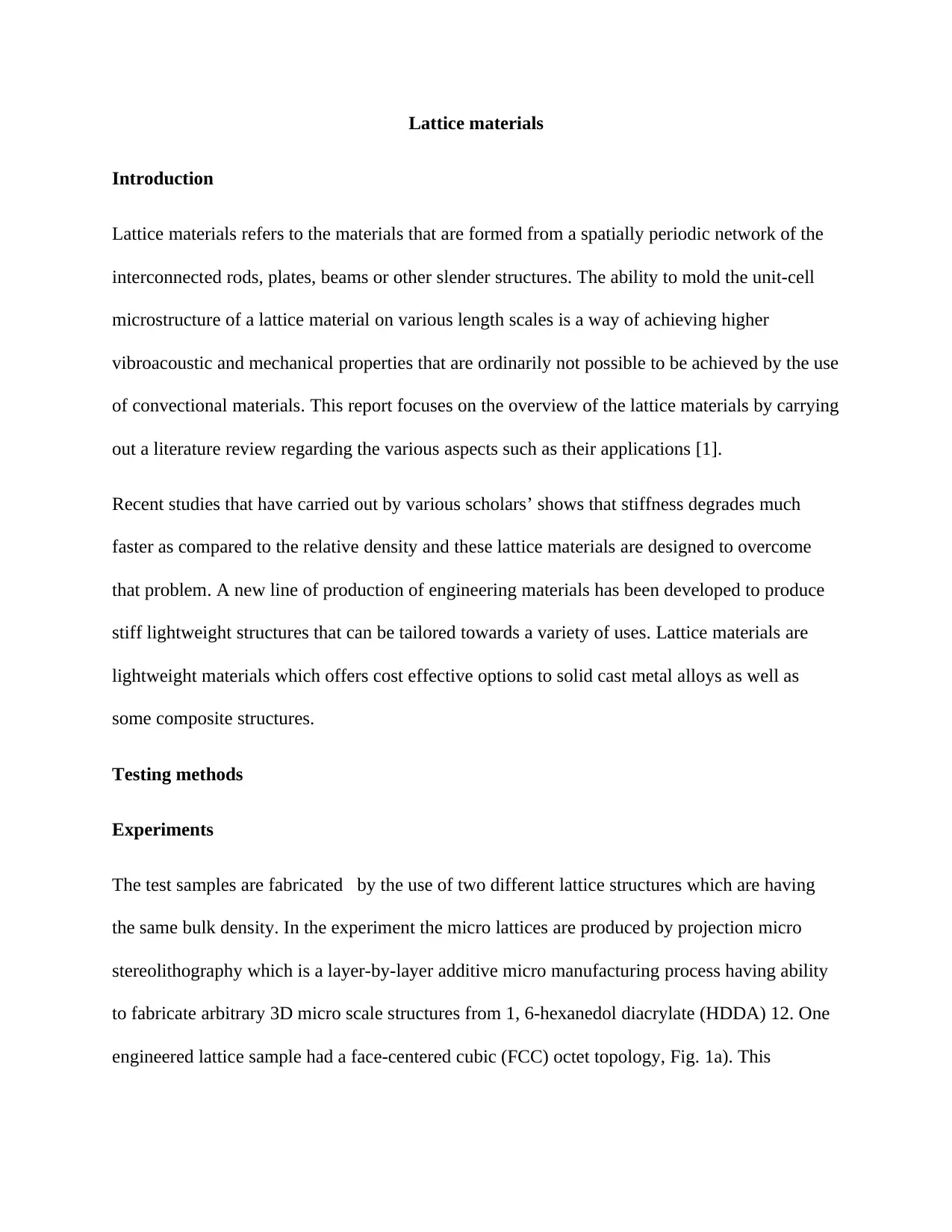
Lattice materials
Introduction
Lattice materials refers to the materials that are formed from a spatially periodic network of the
interconnected rods, plates, beams or other slender structures. The ability to mold the unit-cell
microstructure of a lattice material on various length scales is a way of achieving higher
vibroacoustic and mechanical properties that are ordinarily not possible to be achieved by the use
of convectional materials. This report focuses on the overview of the lattice materials by carrying
out a literature review regarding the various aspects such as their applications [1].
Recent studies that have carried out by various scholars’ shows that stiffness degrades much
faster as compared to the relative density and these lattice materials are designed to overcome
that problem. A new line of production of engineering materials has been developed to produce
stiff lightweight structures that can be tailored towards a variety of uses. Lattice materials are
lightweight materials which offers cost effective options to solid cast metal alloys as well as
some composite structures.
Testing methods
Experiments
The test samples are fabricated by the use of two different lattice structures which are having
the same bulk density. In the experiment the micro lattices are produced by projection micro
stereolithography which is a layer-by-layer additive micro manufacturing process having ability
to fabricate arbitrary 3D micro scale structures from 1, 6-hexanedol diacrylate (HDDA) 12. One
engineered lattice sample had a face-centered cubic (FCC) octet topology, Fig. 1a). This
Introduction
Lattice materials refers to the materials that are formed from a spatially periodic network of the
interconnected rods, plates, beams or other slender structures. The ability to mold the unit-cell
microstructure of a lattice material on various length scales is a way of achieving higher
vibroacoustic and mechanical properties that are ordinarily not possible to be achieved by the use
of convectional materials. This report focuses on the overview of the lattice materials by carrying
out a literature review regarding the various aspects such as their applications [1].
Recent studies that have carried out by various scholars’ shows that stiffness degrades much
faster as compared to the relative density and these lattice materials are designed to overcome
that problem. A new line of production of engineering materials has been developed to produce
stiff lightweight structures that can be tailored towards a variety of uses. Lattice materials are
lightweight materials which offers cost effective options to solid cast metal alloys as well as
some composite structures.
Testing methods
Experiments
The test samples are fabricated by the use of two different lattice structures which are having
the same bulk density. In the experiment the micro lattices are produced by projection micro
stereolithography which is a layer-by-layer additive micro manufacturing process having ability
to fabricate arbitrary 3D micro scale structures from 1, 6-hexanedol diacrylate (HDDA) 12. One
engineered lattice sample had a face-centered cubic (FCC) octet topology, Fig. 1a). This
Paraphrase This Document
Need a fresh take? Get an instant paraphrase of this document with our AI Paraphraser
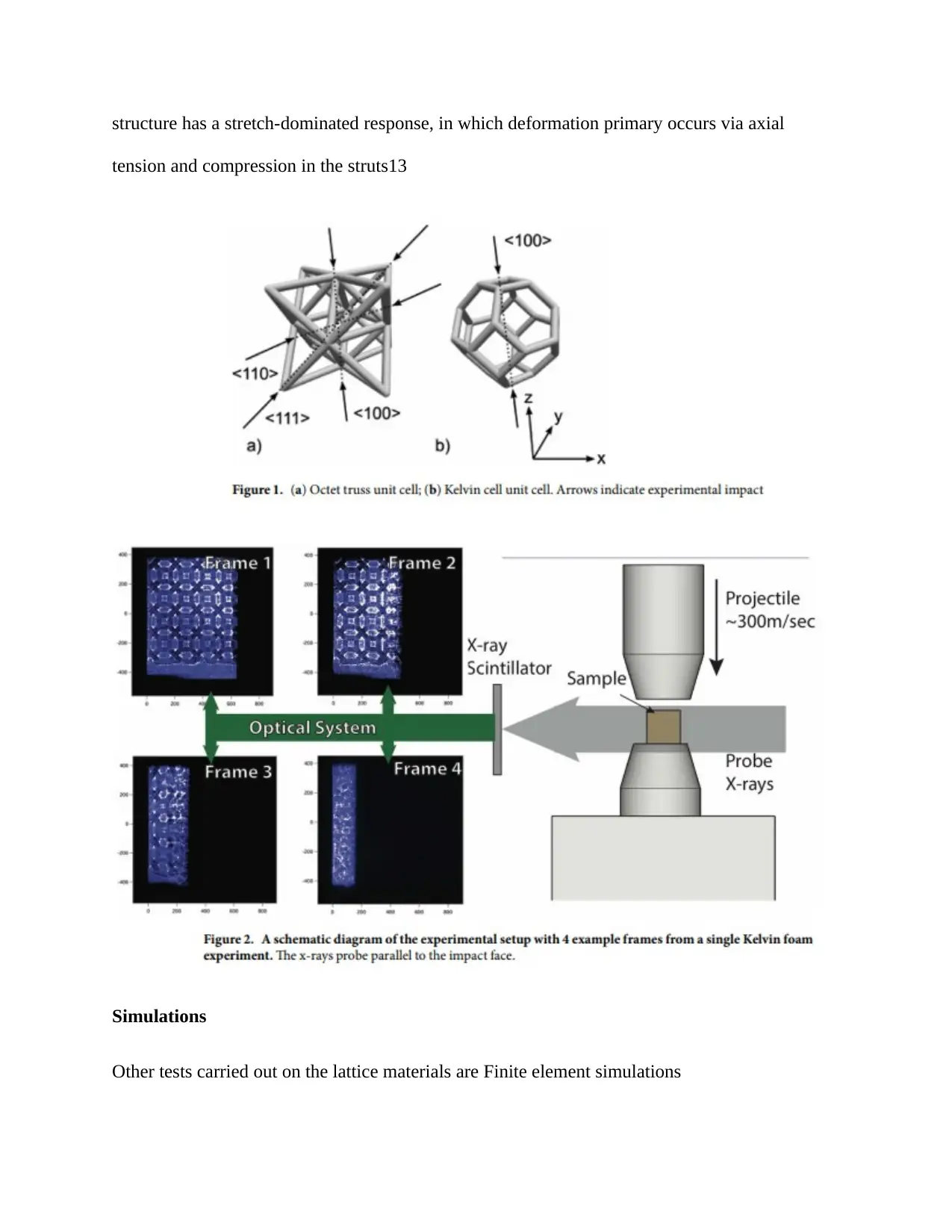
structure has a stretch-dominated response, in which deformation primary occurs via axial
tension and compression in the struts13
Simulations
Other tests carried out on the lattice materials are Finite element simulations
tension and compression in the struts13
Simulations
Other tests carried out on the lattice materials are Finite element simulations
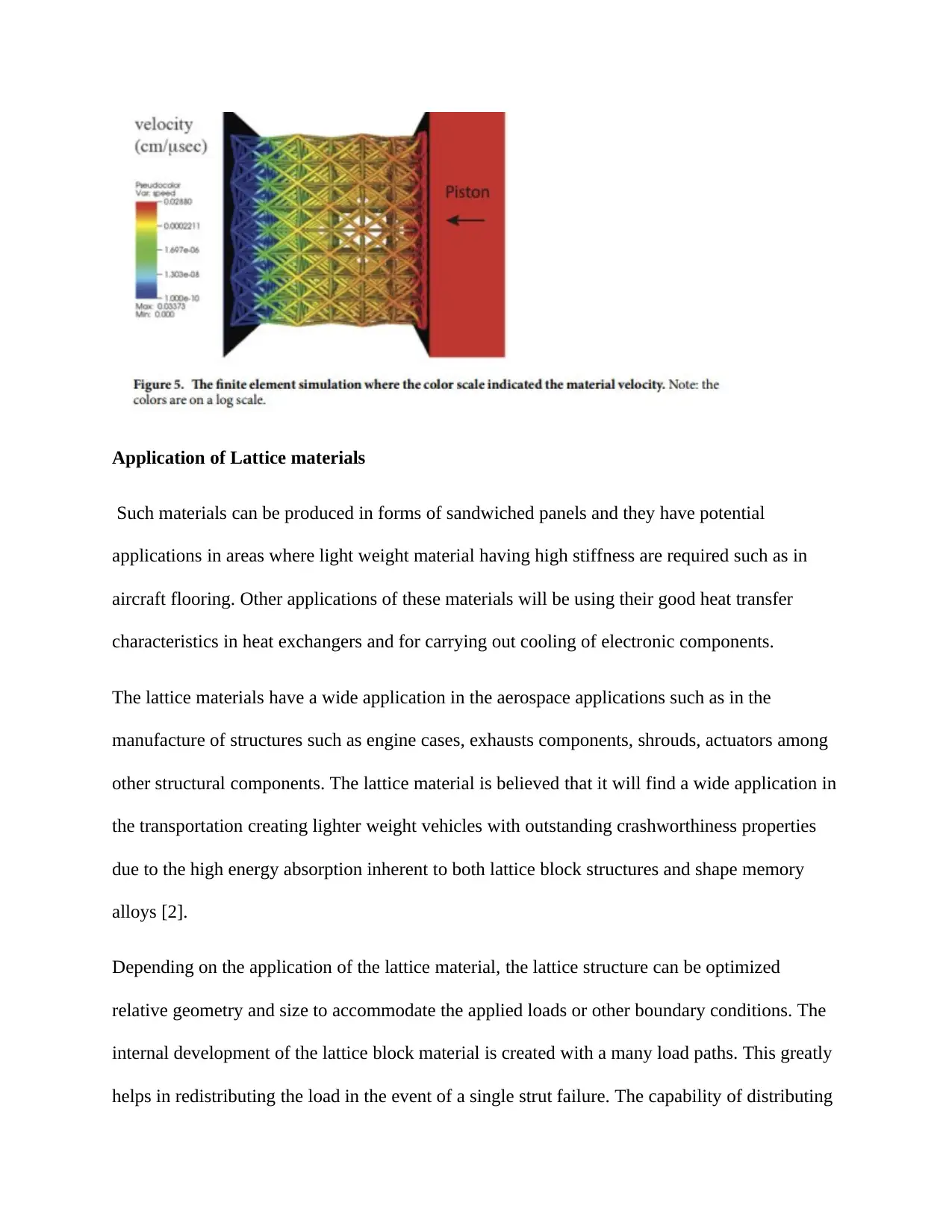
Application of Lattice materials
Such materials can be produced in forms of sandwiched panels and they have potential
applications in areas where light weight material having high stiffness are required such as in
aircraft flooring. Other applications of these materials will be using their good heat transfer
characteristics in heat exchangers and for carrying out cooling of electronic components.
The lattice materials have a wide application in the aerospace applications such as in the
manufacture of structures such as engine cases, exhausts components, shrouds, actuators among
other structural components. The lattice material is believed that it will find a wide application in
the transportation creating lighter weight vehicles with outstanding crashworthiness properties
due to the high energy absorption inherent to both lattice block structures and shape memory
alloys [2].
Depending on the application of the lattice material, the lattice structure can be optimized
relative geometry and size to accommodate the applied loads or other boundary conditions. The
internal development of the lattice block material is created with a many load paths. This greatly
helps in redistributing the load in the event of a single strut failure. The capability of distributing
Such materials can be produced in forms of sandwiched panels and they have potential
applications in areas where light weight material having high stiffness are required such as in
aircraft flooring. Other applications of these materials will be using their good heat transfer
characteristics in heat exchangers and for carrying out cooling of electronic components.
The lattice materials have a wide application in the aerospace applications such as in the
manufacture of structures such as engine cases, exhausts components, shrouds, actuators among
other structural components. The lattice material is believed that it will find a wide application in
the transportation creating lighter weight vehicles with outstanding crashworthiness properties
due to the high energy absorption inherent to both lattice block structures and shape memory
alloys [2].
Depending on the application of the lattice material, the lattice structure can be optimized
relative geometry and size to accommodate the applied loads or other boundary conditions. The
internal development of the lattice block material is created with a many load paths. This greatly
helps in redistributing the load in the event of a single strut failure. The capability of distributing
⊘ This is a preview!⊘
Do you want full access?
Subscribe today to unlock all pages.

Trusted by 1+ million students worldwide
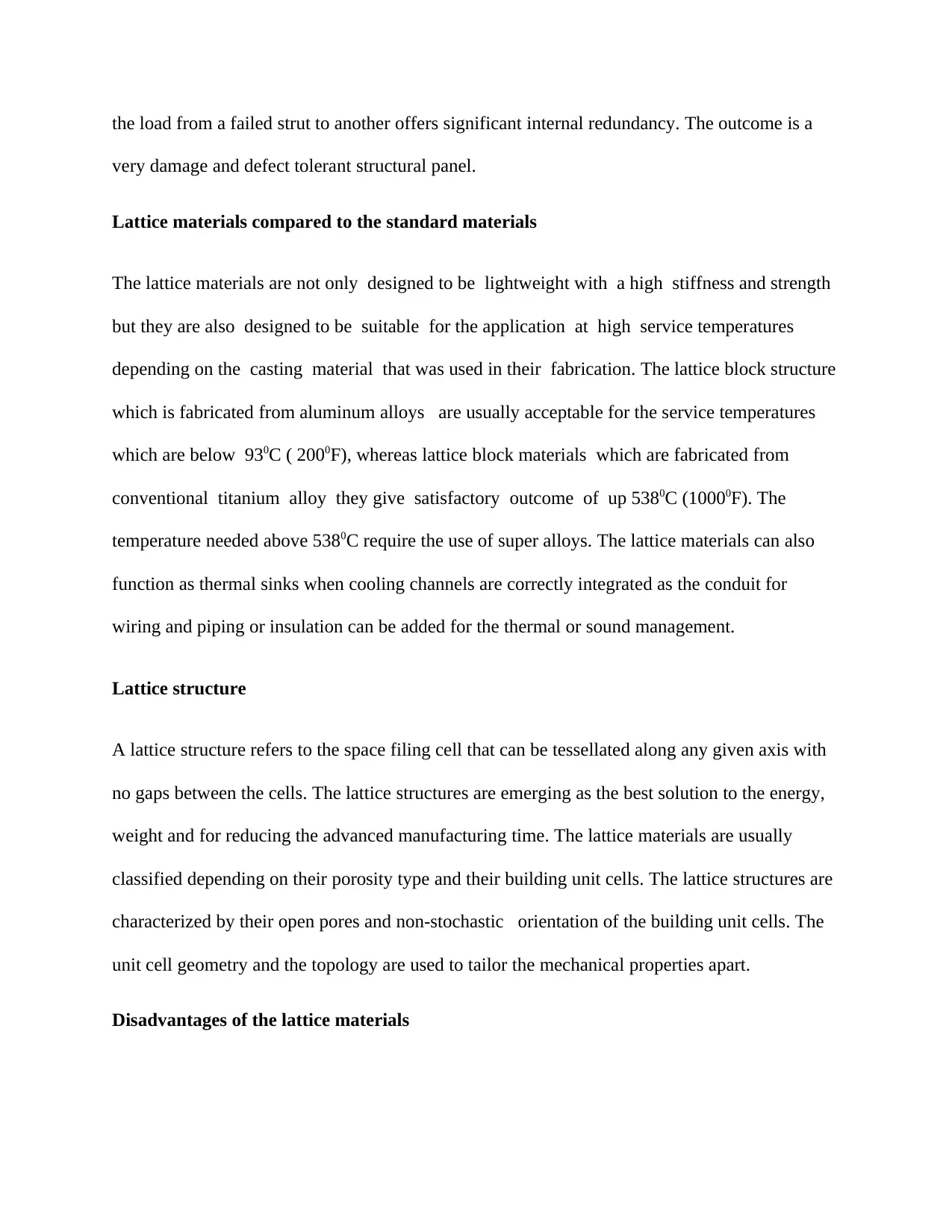
the load from a failed strut to another offers significant internal redundancy. The outcome is a
very damage and defect tolerant structural panel.
Lattice materials compared to the standard materials
The lattice materials are not only designed to be lightweight with a high stiffness and strength
but they are also designed to be suitable for the application at high service temperatures
depending on the casting material that was used in their fabrication. The lattice block structure
which is fabricated from aluminum alloys are usually acceptable for the service temperatures
which are below 930C ( 2000F), whereas lattice block materials which are fabricated from
conventional titanium alloy they give satisfactory outcome of up 5380C (10000F). The
temperature needed above 5380C require the use of super alloys. The lattice materials can also
function as thermal sinks when cooling channels are correctly integrated as the conduit for
wiring and piping or insulation can be added for the thermal or sound management.
Lattice structure
A lattice structure refers to the space filing cell that can be tessellated along any given axis with
no gaps between the cells. The lattice structures are emerging as the best solution to the energy,
weight and for reducing the advanced manufacturing time. The lattice materials are usually
classified depending on their porosity type and their building unit cells. The lattice structures are
characterized by their open pores and non-stochastic orientation of the building unit cells. The
unit cell geometry and the topology are used to tailor the mechanical properties apart.
Disadvantages of the lattice materials
very damage and defect tolerant structural panel.
Lattice materials compared to the standard materials
The lattice materials are not only designed to be lightweight with a high stiffness and strength
but they are also designed to be suitable for the application at high service temperatures
depending on the casting material that was used in their fabrication. The lattice block structure
which is fabricated from aluminum alloys are usually acceptable for the service temperatures
which are below 930C ( 2000F), whereas lattice block materials which are fabricated from
conventional titanium alloy they give satisfactory outcome of up 5380C (10000F). The
temperature needed above 5380C require the use of super alloys. The lattice materials can also
function as thermal sinks when cooling channels are correctly integrated as the conduit for
wiring and piping or insulation can be added for the thermal or sound management.
Lattice structure
A lattice structure refers to the space filing cell that can be tessellated along any given axis with
no gaps between the cells. The lattice structures are emerging as the best solution to the energy,
weight and for reducing the advanced manufacturing time. The lattice materials are usually
classified depending on their porosity type and their building unit cells. The lattice structures are
characterized by their open pores and non-stochastic orientation of the building unit cells. The
unit cell geometry and the topology are used to tailor the mechanical properties apart.
Disadvantages of the lattice materials
Paraphrase This Document
Need a fresh take? Get an instant paraphrase of this document with our AI Paraphraser
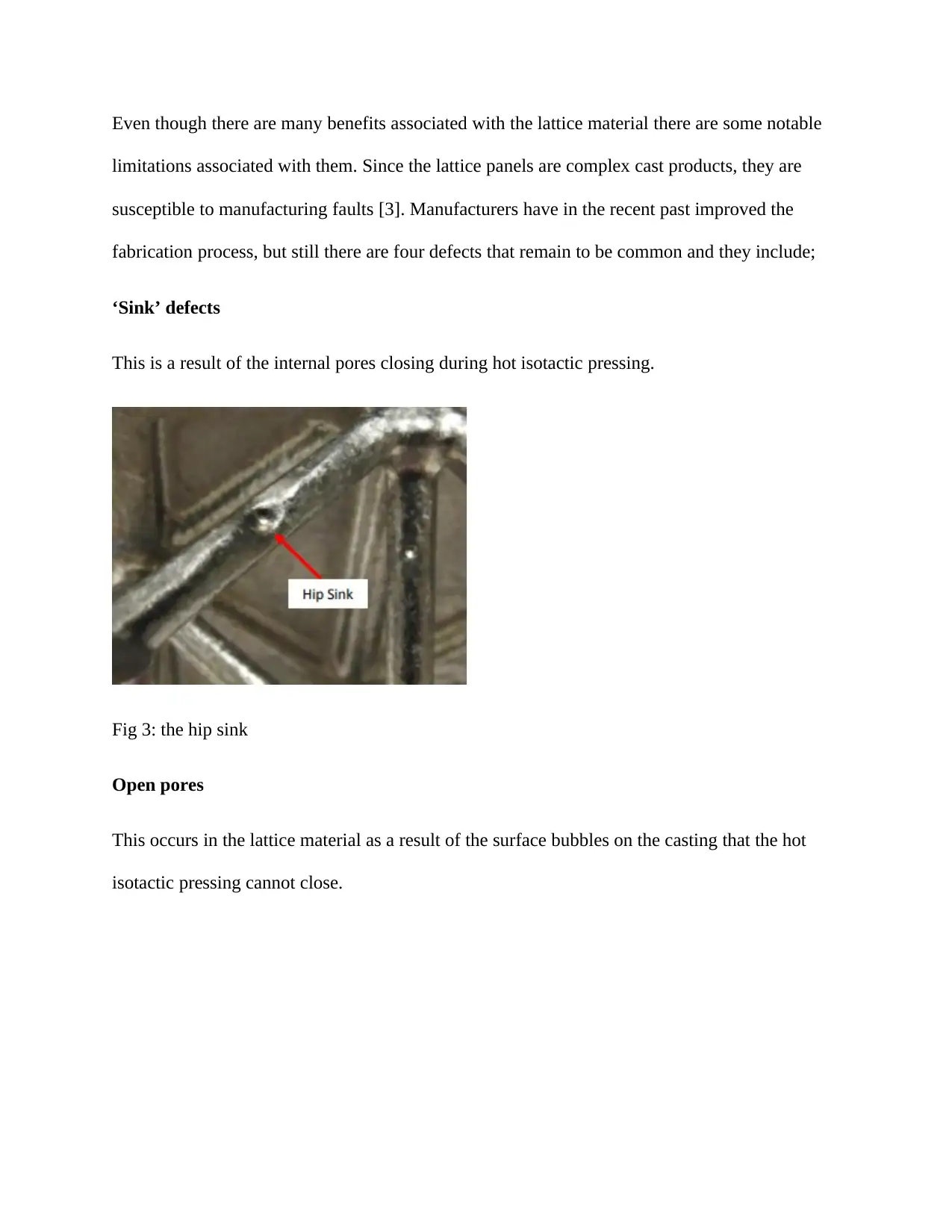
Even though there are many benefits associated with the lattice material there are some notable
limitations associated with them. Since the lattice panels are complex cast products, they are
susceptible to manufacturing faults [3]. Manufacturers have in the recent past improved the
fabrication process, but still there are four defects that remain to be common and they include;
‘Sink’ defects
This is a result of the internal pores closing during hot isotactic pressing.
Fig 3: the hip sink
Open pores
This occurs in the lattice material as a result of the surface bubbles on the casting that the hot
isotactic pressing cannot close.
limitations associated with them. Since the lattice panels are complex cast products, they are
susceptible to manufacturing faults [3]. Manufacturers have in the recent past improved the
fabrication process, but still there are four defects that remain to be common and they include;
‘Sink’ defects
This is a result of the internal pores closing during hot isotactic pressing.
Fig 3: the hip sink
Open pores
This occurs in the lattice material as a result of the surface bubbles on the casting that the hot
isotactic pressing cannot close.
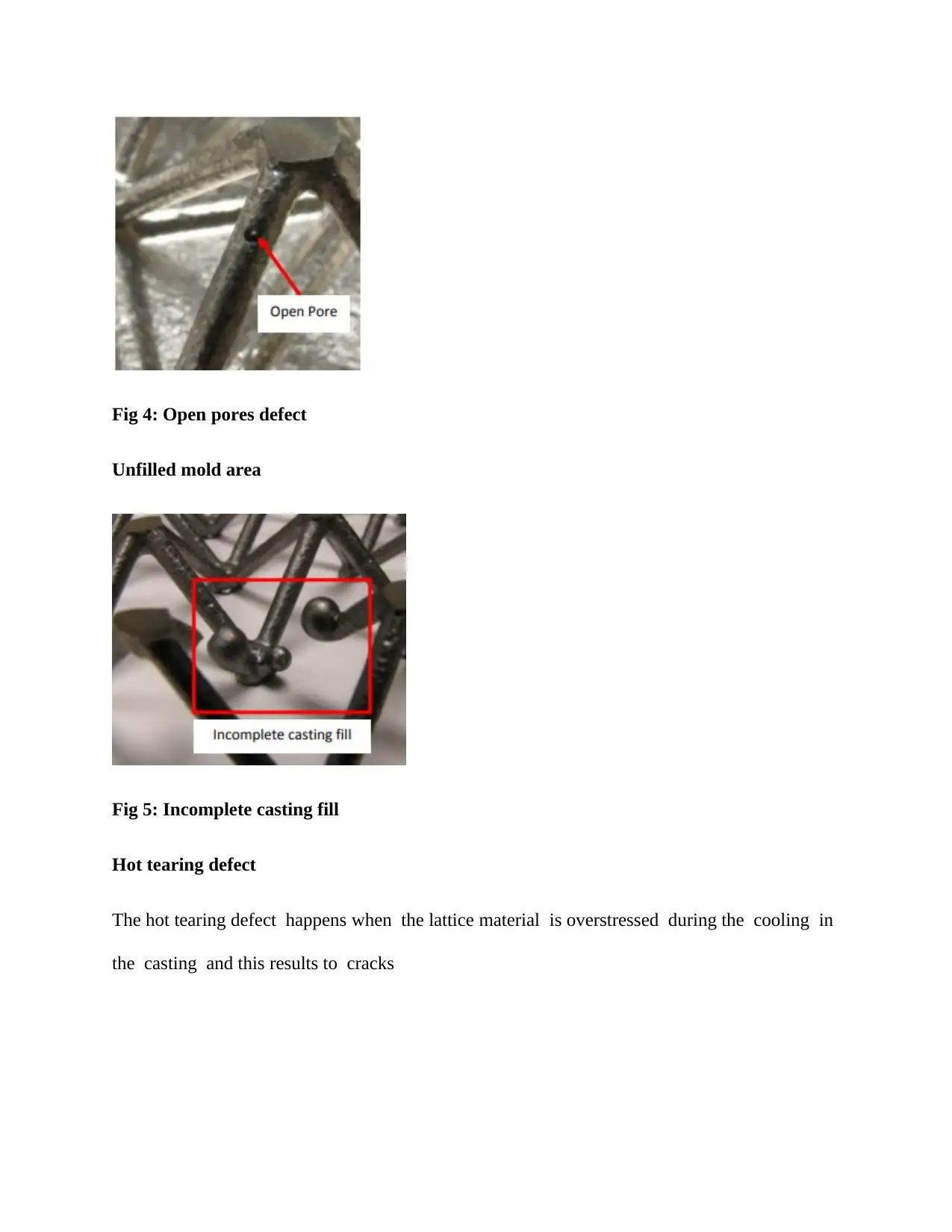
Fig 4: Open pores defect
Unfilled mold area
Fig 5: Incomplete casting fill
Hot tearing defect
The hot tearing defect happens when the lattice material is overstressed during the cooling in
the casting and this results to cracks
Unfilled mold area
Fig 5: Incomplete casting fill
Hot tearing defect
The hot tearing defect happens when the lattice material is overstressed during the cooling in
the casting and this results to cracks
⊘ This is a preview!⊘
Do you want full access?
Subscribe today to unlock all pages.

Trusted by 1+ million students worldwide
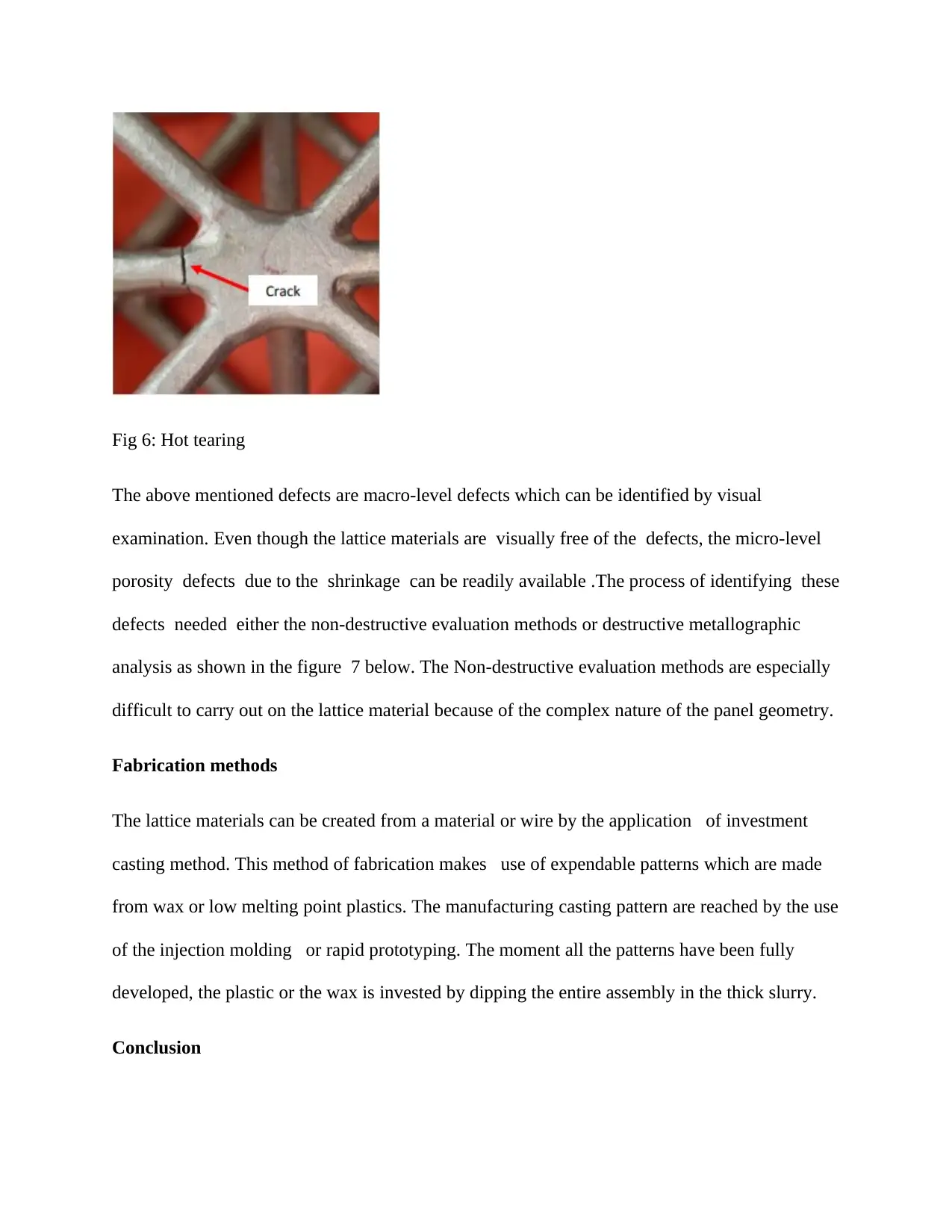
Fig 6: Hot tearing
The above mentioned defects are macro-level defects which can be identified by visual
examination. Even though the lattice materials are visually free of the defects, the micro-level
porosity defects due to the shrinkage can be readily available .The process of identifying these
defects needed either the non-destructive evaluation methods or destructive metallographic
analysis as shown in the figure 7 below. The Non-destructive evaluation methods are especially
difficult to carry out on the lattice material because of the complex nature of the panel geometry.
Fabrication methods
The lattice materials can be created from a material or wire by the application of investment
casting method. This method of fabrication makes use of expendable patterns which are made
from wax or low melting point plastics. The manufacturing casting pattern are reached by the use
of the injection molding or rapid prototyping. The moment all the patterns have been fully
developed, the plastic or the wax is invested by dipping the entire assembly in the thick slurry.
Conclusion
The above mentioned defects are macro-level defects which can be identified by visual
examination. Even though the lattice materials are visually free of the defects, the micro-level
porosity defects due to the shrinkage can be readily available .The process of identifying these
defects needed either the non-destructive evaluation methods or destructive metallographic
analysis as shown in the figure 7 below. The Non-destructive evaluation methods are especially
difficult to carry out on the lattice material because of the complex nature of the panel geometry.
Fabrication methods
The lattice materials can be created from a material or wire by the application of investment
casting method. This method of fabrication makes use of expendable patterns which are made
from wax or low melting point plastics. The manufacturing casting pattern are reached by the use
of the injection molding or rapid prototyping. The moment all the patterns have been fully
developed, the plastic or the wax is invested by dipping the entire assembly in the thick slurry.
Conclusion
Paraphrase This Document
Need a fresh take? Get an instant paraphrase of this document with our AI Paraphraser
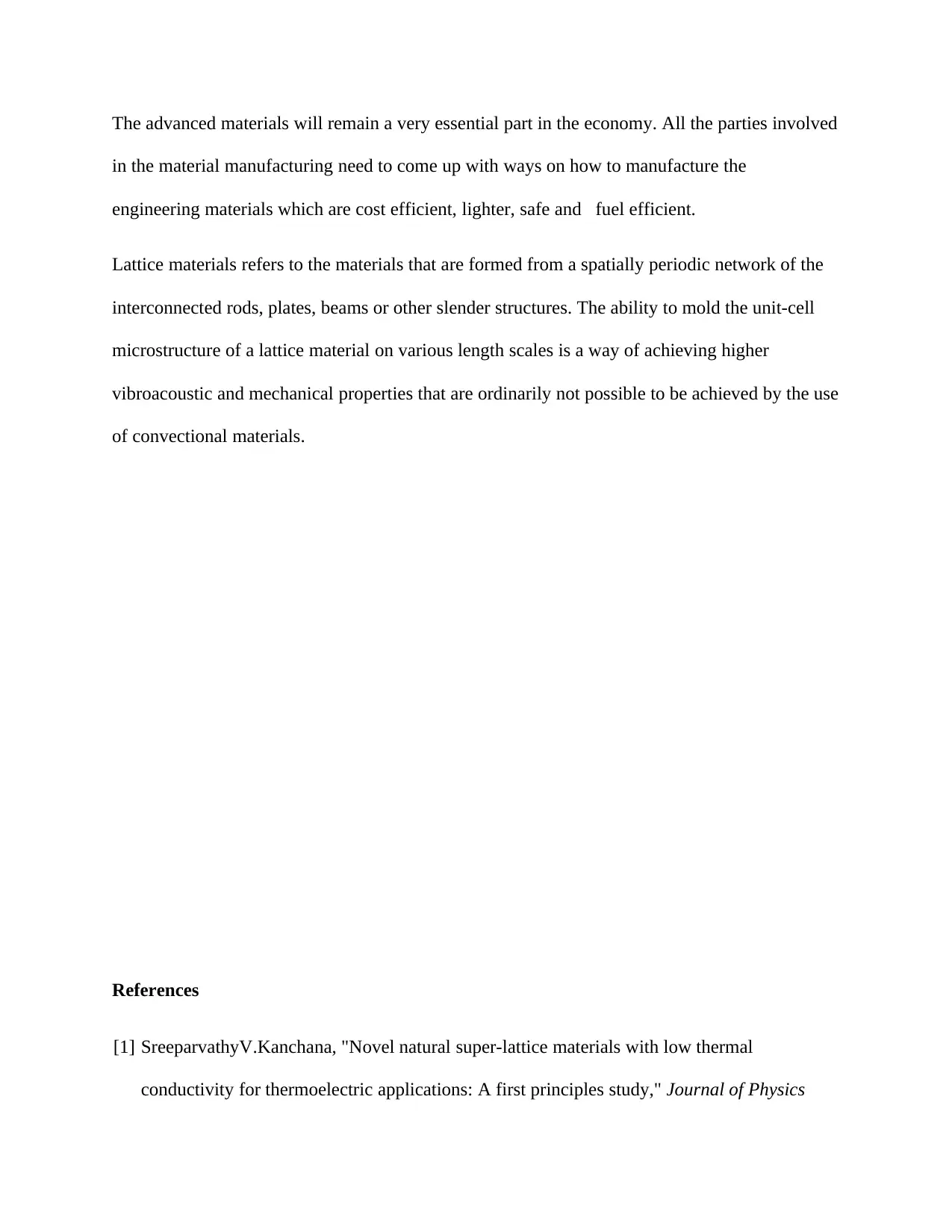
The advanced materials will remain a very essential part in the economy. All the parties involved
in the material manufacturing need to come up with ways on how to manufacture the
engineering materials which are cost efficient, lighter, safe and fuel efficient.
Lattice materials refers to the materials that are formed from a spatially periodic network of the
interconnected rods, plates, beams or other slender structures. The ability to mold the unit-cell
microstructure of a lattice material on various length scales is a way of achieving higher
vibroacoustic and mechanical properties that are ordinarily not possible to be achieved by the use
of convectional materials.
References
[1] SreeparvathyV.Kanchana, "Novel natural super-lattice materials with low thermal
conductivity for thermoelectric applications: A first principles study," Journal of Physics
in the material manufacturing need to come up with ways on how to manufacture the
engineering materials which are cost efficient, lighter, safe and fuel efficient.
Lattice materials refers to the materials that are formed from a spatially periodic network of the
interconnected rods, plates, beams or other slender structures. The ability to mold the unit-cell
microstructure of a lattice material on various length scales is a way of achieving higher
vibroacoustic and mechanical properties that are ordinarily not possible to be achieved by the use
of convectional materials.
References
[1] SreeparvathyV.Kanchana, "Novel natural super-lattice materials with low thermal
conductivity for thermoelectric applications: A first principles study," Journal of Physics

and Chemistry of Solids, vol. 111, no. 67, pp. 54-62, 2017.
[2] T.DebRo, "Additive manufacturing of metallic components – Process, structure and
properties," Progress in Materials Science, vol. 92, no. 34, pp. 112-224, 2018.
[3] R. J.S.Taveira, "Optical band gaps of organic semiconductor materials," Optical Materials,
vol. 58, no. 17, pp. 51-60, 2016.
[2] T.DebRo, "Additive manufacturing of metallic components – Process, structure and
properties," Progress in Materials Science, vol. 92, no. 34, pp. 112-224, 2018.
[3] R. J.S.Taveira, "Optical band gaps of organic semiconductor materials," Optical Materials,
vol. 58, no. 17, pp. 51-60, 2016.
⊘ This is a preview!⊘
Do you want full access?
Subscribe today to unlock all pages.

Trusted by 1+ million students worldwide
1 out of 9
Your All-in-One AI-Powered Toolkit for Academic Success.
+13062052269
info@desklib.com
Available 24*7 on WhatsApp / Email
![[object Object]](/_next/static/media/star-bottom.7253800d.svg)
Unlock your academic potential
Copyright © 2020–2025 A2Z Services. All Rights Reserved. Developed and managed by ZUCOL.


